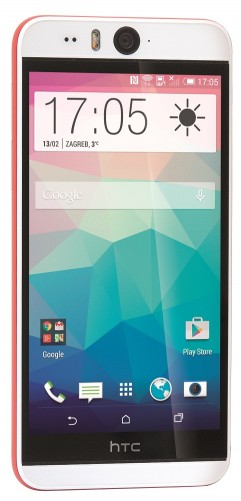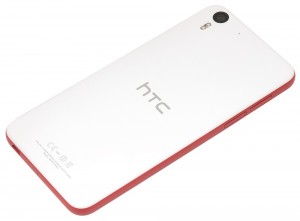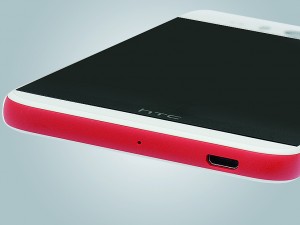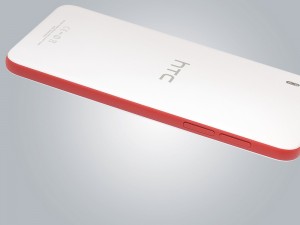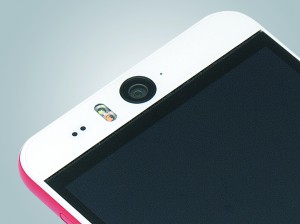QUICK TAKE
Come for the 13-megapixel selfies, stay for the high-end performance and display. In addition to its powerful (if imperfect) pair of cameras, the HTC Desire Eye is just an excellent value, providing near-flagship power at a midrange price.
HTC’s crafted one of the best midrange phones on the market with its new Desire Eye, a playful device that’s just as, if not more technically advanced than its flagship One (M8). Its potent Snapdragon 801 chipset, gorgeous 5.2-inch 1080p display, and stylish water- and dust-resistant body would be big draws on their own, but are actually secondary to the Desire Eye’s most compelling feature – a big and powerful 13-megapixel front-facing camera. And that’s not to mention the above-average shooter on its back.
There are still enough flaws here to remind you why this is a midrange device in the first place, but the Desire Eye is a hard handset to ignore if you love snapping selfies. Let’s dig deeper into the AT&T exclusive, which is now available for $450 unlocked or $70 with a two-year contract.
Build and Design
The Desire Eye is entirely made of plastic outside of its front, which is fully coated in Gorilla Glass 3. It comes in several color schemes, with the rim always contrasting with the back, giving the phone a playful and youthful look. This kind of color may be off-putting to some, but since this is a midrange device, it’s understandable that HTC is willing be a little more outlandish here than it’d be with a hero device like the One.
That’s not to say the Desire Eye feels cheap, though. Like the One, it features a unibody construction, which is rare for a phone with this much plastic. The negative here is that this makes the phone’s battery impossible to remove, but the sturdiness of the build makes that sacrifice easier to swallow. That, and the fact that it allows the phone to be dunked underwater without harm for up to 30 minutes. It’s clear that HTC went into this with the idea of making a plastic phone that’s more aesthetically pleasing than pragmatic, and it’s mostly succeeded in that regard.
Still, you’ll need big hands for this to feel fully comfortable. With a 5.2-inch display, dimensions of 151 x 74 x 8.5 mm (9.97 x 2.91 x 0.33 in), and a weight of 154 grams (5.43 oz.), you likely won’t be able to use the device with one hand. We can’t knock HTC too hard for this given that almost every phone feels supersized nowadays, but a phone made for taking selfies should be more accessible.
The front of the phone, just above the screen, includes the front-facing 13-megapixel camera, the phone’s titular “eye” and most immediately striking feature. It also has a dual-LED flash with a set of the usual sensors. As with most recent HTC phones, there’s an unfortunately huge bezel below the display, which features the infamous HTC logo bar. The capacitive Back, Home, and Tasks keys take up space on the actual display on top of that – a design choice dictated by Android, sure, but a nuisance on this particular device nonetheless. Other 5.2-inch phones like the Moto X has been less wasteful with their real estate, so it’s becoming harder to justify HTC’s insistence on chewing up so much room around its displays.
The back side includes the phone’s second eye, the 13-megapixel rear camera, along with another dual-LED flash and a secondary microphone for reducing ambient noise. One noteworthy design plus here is that both cameras have been physically fused with the front and back, which further protects them from possible damage caused by dragging the phone across a table or other hard surfaces.
The top of the phone includes a 3.5 mm audio jack, while the bottom houses the microUSB slot and primary microphone. The left side features covered microSD and nanoSIM card slots, while the right includes the Power key, volume rocker, and a dedicated camera key, which turns the camera on from standby in impressive time. These keys are a little too shallow to press, but they never become too much of an annoyance in practice.
Display
The Desire Eye comes with a 5.2-inch Full HD IPS display, resulting in a respectable pixel density of 424 ppi. The panel is very much similar to that of the One (M8), so it shouldn’t be surprising to hear that it’s generally excellent. It’s consistently sharp and exceptionally bright, with lively colors and enduring quality in direct sunlight. It wouldn’t be a stretch to call this a flagship-level screen, which is refreshing to see in a phone of this price.
If there’s any shortcoming here, it’s that darker colors could stand to be a bit fuller. This is an IPS screen, not an OLED one, so while whites here are wonderfully bright and clean, black tones are rather light, sometimes looking closer to grey than anything else. Photos or video clips taken in darker rooms and games with darker designs will seem paler than they actually are, which doesn’t ruin things but could understandably be problem for perfectionists.
Performance
As mentioned above, the Desire Eye is equipped with Qualcomm’s frequently used Snapdragon 801 SoC, which comes with four Krait 400 cores running at 2.3 GHz and an Adreno 330 GPU. It also carries the standard 2 GB of RAM. In practice, such internals — combined with a 1080p display, Android 4.4.4 (KitKat), and HTC’s Sense UI 6.0 skin — help the phone run fast in just about any everyday situation. Scrolling through Sense yields very few moments of stuttering or glitching, apps consistently load fast, and graphically demanding games run without a hitch the vast majority of the time.
The Snapdragon 801 is technically a last-generation chipset at this point, so it’s a bit slower than newer phones in benchmark testing, but the differences between it and its successors on a phone like this are barely noticeable in day-to-day use unless you set out to find them. One of the feasible benefits of performance increases becoming so marginal over the years is that you can get close to high-end speed at a less-than-high-end price, so it’s nice to see that HTC hasn’t been stingy with its midrange model here.
On the storage front, the Desire Eye comes with a meager 16 GB by default — but thankfully that can be expanded with microSD cards up to 128 GB, which is plenty of room for holding all your self-portraits.
Battery Life
The Desire Eye comes with a non-removable 2400 mAh battery that’s usually good for around a day and a half of life with normal use. This is one area where the Desire Eye is inferior to the One (M8) on the spec sheet, as that flagship had a slightly larger 2600 mAh pack. Nevertheless, the battery here is slightly above-average for a smartphone in this price range, and should get you through your average workday with few complaints. If you do find yourself running out of juice, however, HTC’s Sense software has a nifty extreme power saver mode that limits the phone to its most essential functions but squeezes a few more hours out of its dying breaths.
Software
HTC’s Sense UI 6.0 is back running the show here, and it’s pretty much identical to the skin we reviewed with the One (M8). It still alters the look of Android fairly significantly, but does a good job of not totally changing the feel of it. It can’t hold a candle to the smoothness of stock Android, but it’s competent enough, comes with a few useful features (like the BlinkFeed news reader), and never feels too much in the way. It is due for an update, however.
More annoying is what’s running underneath Sense. The Desire Eye comes with Android 4.4.4 KitKat, which is stable enough, but now feels dated after the launch of Android 5.0 “Lollipop.” Lollipop is a major step forward for Google’s mobile OS in both looks and functionality, and while Sense may cover most of its visual changes up, it still feels wrong to have a new phone running old software. HTC hasn’t given any hints as to when the Desire Eye will get the upgrade either – though it has for the One (M8) and One (M7) — so it may be some time before Desire owners get up to speed.
Camera
The Desire Eye’s dual 13-megapixel cameras are its biggest hooks. The selfie cam in particular is probably the reason this phone even exists – there simply isn’t another front-facing camera that’s this beefed up. Both front shooters are equipped with a dual-LED flash and autofocus, but differ in certain optical characteristics, leading them to vary in actual photo quality.
To be specific, the back camera has an f/2.0 aperture and a narrower viewing angle, while the front-facing camera offers a more closed aperture of f/2.2, but a wider viewing angle to fit more people into a selfie shot. HTC’s UI is identical for both cameras – just swipe a finger from left to right to change sides and off you go.
Despite having the same resolution as the front-facing camera, the rear unit takes better photographs on the whole. Its shots are more precisely exposed, include an above average level of detail, and maintain good white balance without oversaturating colors. More attention will go to its front-facing companion, but the main camera here is a wholesale upgrade over the “Ultrapixel” cams of the last two One phones, and that’s significant. It isn’t on the level of an iPhone orLumia, but it’s a reason to be excited for future HTC devices.
The front-facing camera, meanwhile, is a little more disappointing in practice. Its photos tend to come out too grainy and off-color, with things going especially haywire in low-light settings. Having a dedicated flash helps, but it doesn’t free the cam from all focusing issues. It’d be underwhelming if this unit was on the back on the phone, in other words. Still, the high megapixel count means it can capture plenty of detail, the wide-angle lens does its job well, and the exposure and white balance of its shots are usually pretty precise. Ultimately, this camera is just too strong to be anything less than the best selfie machine on the market — even if it doesn’t blow the usual cameras out of the water the way its specs would suggest. Either way, getting this pair of cameras on a midrange phone like this is great value.
Conclusion
The Desire Eye packs flagship hardware packed into upper midrange body, providing the kind of display, performance, and battery life you’d normally get from a phone $100-200 more expensive. That alone makes this phone a winner (if you can live with a slightly outdated OS), but its dual 13-megapixel cameras are what really make it stand out. If you find yourself craving a better class of selfie, you won’t do much better than the Desire Eye.
